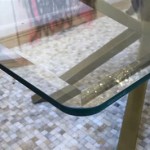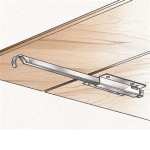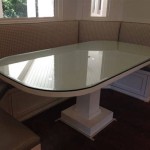The Enduring Appeal of a Rustic Wood Coffee Table
The rustic wood coffee table has become a staple in interior design, prized for its ability to blend seamlessly with diverse aesthetics while adding a touch of warmth and natural charm. Its popularity stems from the genuine character of wood, showcasing unique grains, knots, and textures that tell a story and impart a sense of history. This article delves into the various aspects of rustic wood coffee tables, exploring their design, material, functionality, and the ways they contribute to the overall ambiance of a living space.
Rustic design, at its core, celebrates imperfections and the beauty of raw materials. This is reflected in the deliberate use of reclaimed wood, distressed finishes, and visible joinery techniques. The coffee table, often positioned as the focal point of a living room, plays a critical role in defining the room's style. A rustic wood coffee table anchors the space, providing both aesthetic appeal and practical utility.
The term “rustic” encompasses a broad spectrum of styles, ranging from farmhouse chic to industrial rustic, and even incorporating elements of bohemian and Scandinavian design. The versatility of wood allows it to be manipulated into various shapes and sizes, accommodating diverse needs and preferences. Furthermore, the natural color variations within different wood species contribute to the uniqueness of each piece, ensuring that no two rustic wood coffee tables are exactly alike.
The Variety of Wood Used in Rustic Coffee Tables
The selection of wood is paramount in determining the overall look and feel of a rustic coffee table. Various types of wood are commonly employed, each possessing distinct characteristics that influence the table's durability, appearance, and price point.
One popular choice is reclaimed wood, often sourced from old barns, factories, or even railroad ties. Reclaimed wood carries a history of its own, exhibiting weathering, nail holes, and other imperfections that contribute to its unique character. Using reclaimed wood is also an environmentally conscious choice, as it diverts materials from landfills and gives them a new lease on life.
Pine is another frequently used wood, appreciated for its affordability and workability. It is a relatively soft wood, making it easy to shape and customize. However, its softness also means that it is more susceptible to dents and scratches, which can actually enhance the rustic aesthetic over time. Pine is often stained or painted to achieve the desired color and finish.
Oak is a hardwood known for its strength and durability. Its prominent grain pattern adds visual interest, and it accepts stains and finishes well. Oak is a more expensive option than pine, but its longevity and resistance to wear and tear make it a worthwhile investment.
Maple is another durable hardwood that offers a smoother surface than oak, making it suitable for those who prefer a more refined rustic look. Its light color allows for a wide range of staining options, from light and airy to dark and dramatic.
Walnut is a premium hardwood characterized by its rich, dark color and distinctive grain patterns. It is a highly sought-after wood for furniture making due to its beauty and durability. Walnut rustic coffee tables often exude a sense of elegance and sophistication while maintaining a connection to nature.
Beyond these common choices, other wood varieties such as cedar, fir, and even exotic hardwoods can be used to create unique and visually striking rustic coffee tables. The specific wood selection significantly influences the table's final appearance and its ability to complement the surrounding décor.
Design Elements Defining the Rustic Aesthetic
Several design elements contribute to the distinctive look of a rustic wood coffee table. These elements are carefully considered during the crafting process to ensure that the table embodies the desired rustic charm.
A prominent feature is the use of visible wood grain and knots. These natural imperfections are not concealed but rather celebrated, adding character and a sense of authenticity to the table. The knots, in particular, highlight the table's origins in nature and the unique story of the tree from which the wood was sourced.
Distressed finishes are another common element. Techniques such as sanding, wire brushing, and distressing with tools are employed to create the appearance of age and wear. This gives the table a sense of history and makes it feel like a cherished heirloom.
The shape and overall design of the table can also contribute to its rustic appeal. Simple, clean lines are often favored, allowing the natural beauty of the wood to take center stage. However, some rustic coffee tables incorporate more elaborate designs, such as live edges, which showcase the natural curves and contours of the tree from which the wood was cut.
Metal accents, such as iron legs or hardware, are often incorporated to add an industrial touch to the rustic design. The contrast between the warmth of the wood and the coolness of the metal can create a visually appealing and balanced aesthetic. These metal elements often feature a dark, weathered finish to further enhance the rustic look.
The joinery techniques used in constructing the table also play a role in its overall appearance. Visible joinery, such as dovetail joints or mortise-and-tenon joints, can add a handcrafted feel to the table and showcase the skill of the artisan who created it.
The height and size of the table should also be considered in relation to the surrounding furniture. A rustic coffee table that is too small or too large can disrupt the balance of the room and detract from its overall aesthetic. The ideal size will depend on the size of the sofa and the overall dimensions of the living space.
Functionality and Integration into the Living Space
Beyond its aesthetic appeal, a rustic wood coffee table must also be functional and serve a practical purpose within the living space. It should provide a surface for placing drinks, books, and other items, while also offering a comfortable and inviting focal point for gatherings and relaxation.
The surface area of the table should be sufficient to accommodate the needs of the household. Consider the number of people who typically use the living room and the types of activities that take place there. A larger table may be necessary for families with children or for those who frequently entertain guests.
Some rustic coffee tables incorporate storage solutions, such as shelves or drawers, to help keep the living room organized. These storage features can be particularly useful for storing remote controls, magazines, or other items that tend to clutter the space.
The height of the table should be comfortable for reaching items while seated on the sofa. A coffee table that is too low or too high can be uncomfortable to use and detract from the overall enjoyment of the living space. A good guideline is to choose a table that is approximately the same height as the seat cushions of the sofa.
The placement of the coffee table is also important. It should be positioned in a way that allows for easy access to the sofa and chairs, while also leaving enough space for people to move around freely. A common rule of thumb is to leave approximately 18 inches of space between the coffee table and the sofa.
When choosing a rustic wood coffee table, it is important to consider the overall style of the living room. The table should complement the other furniture and décor in the room, creating a cohesive and harmonious aesthetic. A rustic coffee table can be easily integrated into a variety of styles, from farmhouse to modern, by carefully selecting the wood, finish, and design elements.
The maintenance of a rustic wood coffee table should also be taken into account. Wood is a natural material that requires regular cleaning and care to keep it looking its best. Dusting the table regularly with a soft cloth is essential, and occasional cleaning with a wood cleaner may be necessary to remove dirt and grime. Depending on the finish, periodic oiling or waxing may also be required to protect the wood and keep it looking its best. With proper care, a rustic wood coffee table can last for many years and become a cherished piece of furniture within the home.
In summary, the rustic wood coffee table embodies a timeless appeal stemming from its inherent connection to nature and its ability to convey a sense of history and authenticity. Through the deliberate selection of wood, the incorporation of distressed finishes and visible grain, and the thoughtful consideration of functionality, this furniture piece contributes significantly to the character and comfort of a living space.

Rustic Wooden Coffee Table Live Edge Black Walnut Sofa Finland

Rustic Handmade Solid Wood Sleeper Coffee Table Xtra Large Wide Version

Rustic Teak Wood Coffee Table Brown Olivia May Target

Rustic Farmhouse Rectangular Coffee Table Pottery Barn

Rustic Coffee Table Wood Pine Country

Firstime Co 48 In Rustic Espresso Large Rectangle Wood Coffee Table With Casters 70084 The Home Depot

Rustic Reclaimed Wood Coffee Table Antique Farmhouse

Reclaimed Wood Rectangle Coffee Table Kase Custom

Diy Coffee Tables Country Roads Alder Wood Table See More At Https Missdiystudio Com Square

Modern Wood Coffee Table Rectangle Shaped In Natural Rustic Homary








